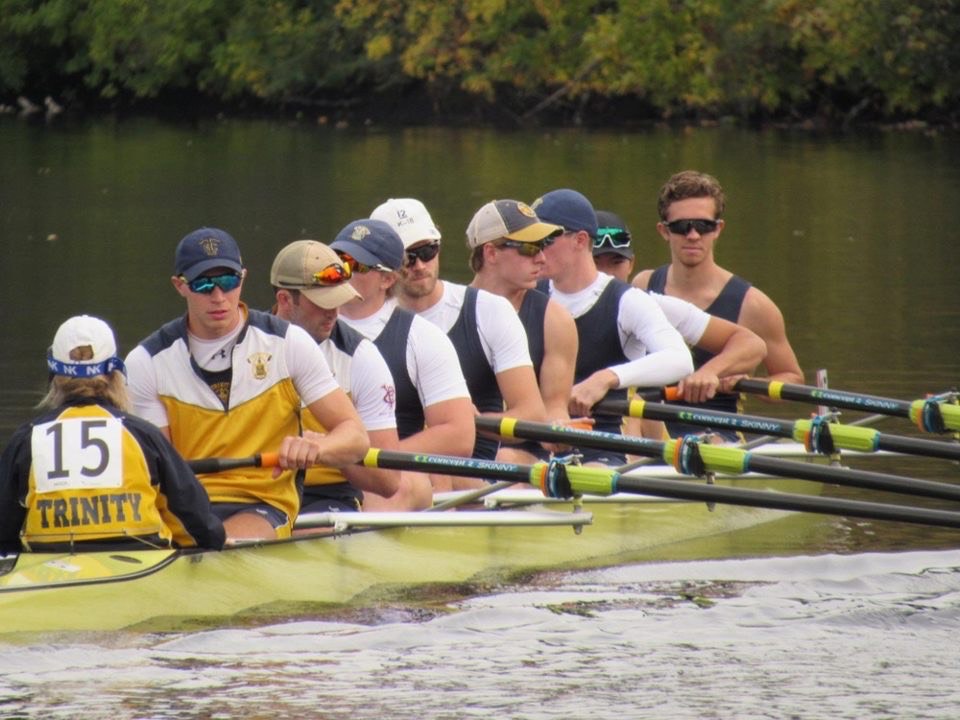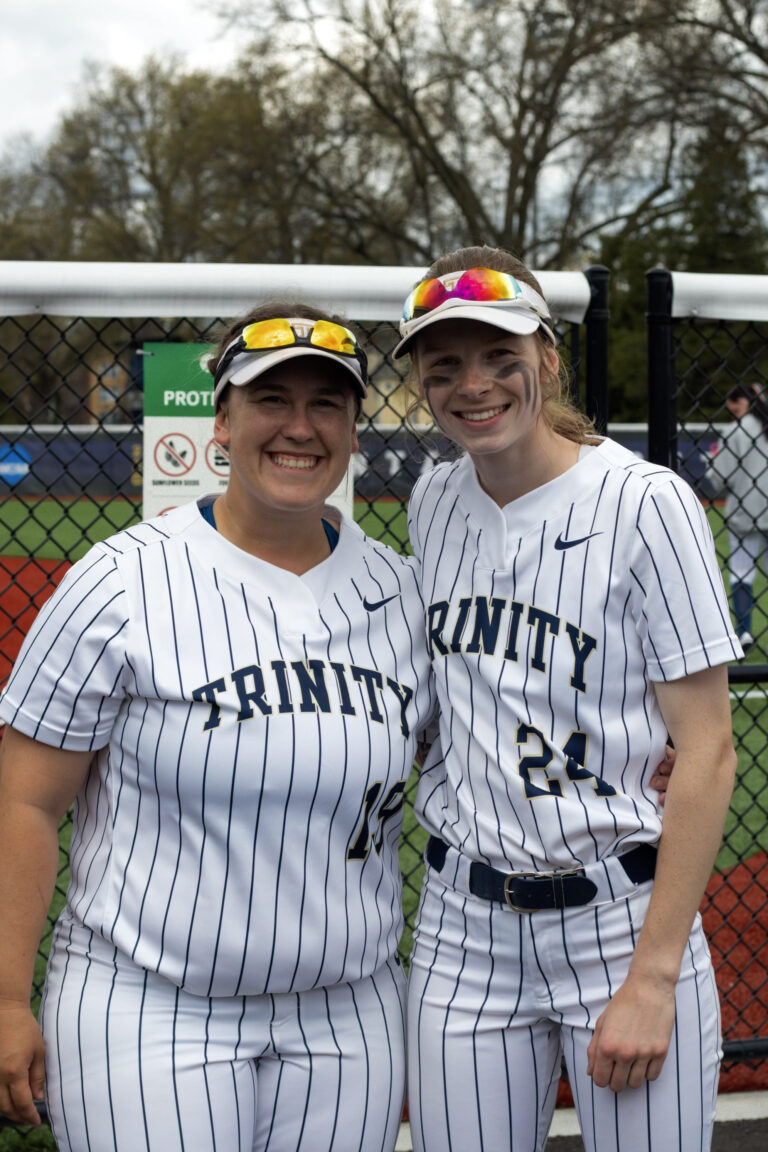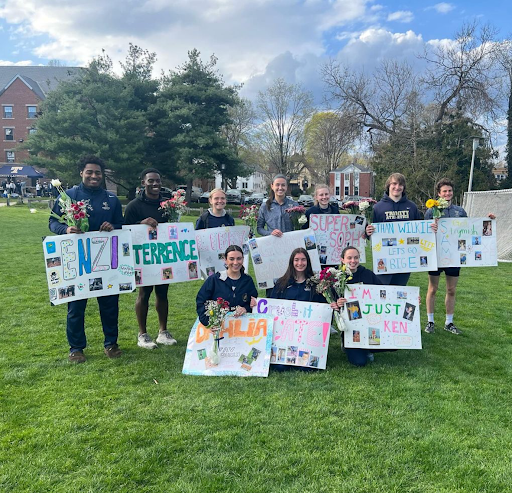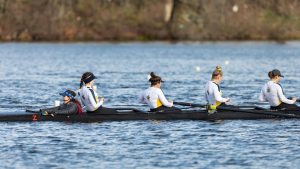Mateo Vazquez ’21
Sports Editor
This past weekend the men’s rowing team got a chance to be featured in both the Collegiate eight and the Collegiate four at the Head of the Charles (HOCR). The competition in both events was quite intense as Trinity was going up against a vast array of NESCAC teams including Williams, Wesleyan, Bates, and Conn. College all of which were presenting very competitive eights for this year’s race.
On Saturday, the team arrived at CRI around noon just in time to see their coach Kevin McDermott get back from the end of his race in the men’s senior master four (50+) rowing under the Palm Beach Rowing Association. He did particularly well, placing 4th out of 34th completing the course in a time of 18:05. After, a quick rigging of the boats, the team stayed to the waters of CRI as they practiced for Sunday’s race. It was a serene experience as the chaos of racing was a ways down shore. If anything, the practice row was an almost tranquil experience to get some strokes in on the Charles. One of the aspects of the course that the crew practiced in particular was turns.
The HOCR is often referred to as a coxswain race because a turn can legitimately make or break a crew’s results.
One of the turns in particular – the Elliot Bridge – is by far one of the most notorious turns as many crews often must make emergency veering off course or risk colliding with the bridge or another crew (something that happens in almost every event). Hence, if a crew cannot execute these turns efficiently, the last stretch of the race could be lost within a matter of seconds. However, this thought was far away from Trinity’s oarsmen’s mind as they focused on following the man in front of them. They continued throughout practice with this intense focus practicing a rowing term of “head in the boat,” quite literally just focusing on the oarsmen and task in front of them and ignoring the distractions outside of the boat.
It is quite easy along the 5000 meters of the Charles to get distracted by the chanting of fans and chaos of boats passing and trying to pass other boats or even the threats of collisions. This is why “head in the boat” ideology is such a crucial aspect to put into practice.
On Sunday morning, the team took to the waters. The lineup for the crews consisted of: Jack Reid ’20, Nicholas Roll ’21, Kenneth Somerville ’21, Peter Teel ’21, Jack Impronto ’23, Aidan Lee ’21, Aaron Xing ’23, Tyler Brennan ’22, and coxswain Amelia Churchill ’21 in the men’s eight. In the four the lineup was: Andrew Frankini ’21, Jeffrey Pendergast ’23, Matthew Vazquez ’21, Chad Obrey ’23, and Liam O’Connor ’23. After a nice steady state and warmup down the course, the team found themselves right around Boston University (directly across from the giant CITGO sign).
At the start is where the vast array of competition can truly be seen.Hundreds of crews in the warmup areas and more getting in line approaching the starting block is quite a breath-taking sight. Yet it is once again a crucial moment to practice “head in the boat” and focus just on the race ahead. As the Bantams approached the start, they were set to follow Williams College and knew that if they were going to be in any contention to finish the race in a good position, they would have to stick with them throughout the course. Right out of the start the Bantams were cooking at race pace settling in from their high sprint into a smooth and steady pace down the course putting them in a good mindset to attack the rest of the race. It was quite intense as they passed through multiple bridges, they kept their composure and were able to maintain the margin between them and Williams keeping the race very close. Behind them was the University of California Santa Barbara (UCSB) and it became quite clear very quickly that the real race was between Williams and Trinity as UCSB began to fall off from the rest of the pack. As the crew approached what would be the tightest turn in the race the Elliot Bridge, coxswain Amelia Churchill ’21 called for strong starboard pressure.
Almost instantly the crew responded, and she was able to thread the needle just allowing the buoys to scrape against the side of the boat putting the crew in the shortest and best possible line for the turn. However, as they were coming under the Elliot, they were held up by the Rutgers crew as they failed to yield early enough. Yet, the crew kept their “head in the boat” and as soon as they had the chance, passed through Rutgers within a few strokes. The rest of the race was a blur as they crossed the finish shortly after closing the margin on Williams with every step of the way. In the end, the varsity eight finished in 11th place overall and was the top NESCAC team at the HOCR.
The Bantams four also presented a strong finish in their event. After an explosive start, the crew settled right into a solid rhythm and began closing the margin on the University of Washington St. Louis crew ahead of them. The four also had an amazing course line and turn as their coxswain Liam O’Connor ’23 placed them on a beautiful line through the Elliot turn. As the crew came through the Elliot Bridge, they began building their sprint and finished stern to bow on the University of Washington St. Louis crew. The four finished 18th overall, and hence requalified again for next year.
This year the HOCR is a huge accomplishment for the Bantams as they recently added two freshmen, Aaron Xing and Jack Impronto, to the varsity crew, as well as freshmen Jeff Prendergast and Chad Obrey in the four. The HOCR is a testament of how far the team has come and the degree to which they have worked to obtain that speed. With the fall championships coming up for this weekend, the team is in a great position to once again dominate the NESCAC.











+ There are no comments
Add yours